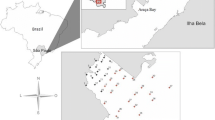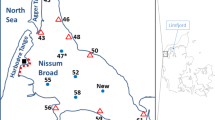Abstract
In Brazil mercury is used indiscriminately at prospecting sites for gold extraction, with a consequent enormous discharge of this metal into the aquatic ecosystem. Mercury concentration was investigated in 1995, 1996 and 1997 in the sediments of ten sites along the Carmo stream, MG, Brazil, almost all of them located in prospecting areas. Analysis of mercury in the sediments of all sampling sites showed that the levels were above the tolerable limit (0.1μg g−1), except for sites P4 (1997), P6 (1995) and P9 (1995 and 1997). The results showed wide mercury contamination in an environment not limited to the active or inactive prospecting areas, but also including sites outside these areas but downstream from them. There was a high incidence of bacteria resistant to mercury in the aquatic communities of the sites under study, ranging from 27.3 to 77.1%, except for P1 (an ecological station upstream from the sites under study) in which all bacteria isolated from water were sensitive. Furthermore, the fall in mercury concentration in the sediment at site P5 was not as marked as at other sites, with a frequency of resistant bacteria of only 27.3%, possibly indicating a slower detoxification. The statistical analysis (Pearson’s correlation = − 0,527) showed that the hypothesis about negative correlation between the incidence of bacterial resistance and the total mercury concentration in this environment is supported. Hence, all these data denote a moderate association between the distribution of resistant bacteria and the presence of mercury compounds.
Similar content being viewed by others
References
Airey, D. & P. D. Jones, 1980. Mercury in the River Mersey, its a estuary and tributaries during 1973 and 1974. Wat.Res. 12: 565–577.
Baldi, F. & G. J. Olson, 1987. Effects of cinnabar on pyrite oxidation by Thiobacillus ferroxidans and cinnabar mobilization by a mercury-resistant strain. Appl. envir. Microbiol. 53: 772–776.
Barkay, T., 1985. Preparation of DNA gene probe for detection of mercury resistance genes in gram-negative bacterial communities. Appl. envir. Microbiol. 49: 686–692.
Barkay, T. & B. H. Olson, 1986. Phenotypic and genotypic adaptation of aerobic heterotrofic sediment bacteria communities to mercury stress. Appl. envir. Microbiol. 52: 403–406.
Barkay, T., 1987. Adaptation of aquatic microbial communities to Hg2+ stress Appl. envir. Microbiol. 53: 2725–2732.
Barkay, T., C. Liebert & M. Gillman, 1989. Environmental significance of the potential for mer (Tn21)-mediated reduction of Hg2+ to Hg0in natural waters. Appl. envir. Microbiol. 55: 1196–1202.
Barkay, T., M. Gilman & C. Liebert, 1990. Genes encoding mercuric recdutases from selected gram-negative aquatic bacteria have a low degree of homology with merA of transposon Tn501. Appl. envir. Microbiol. 56: 1695–1701.
Barkay, T., R. Turner, E. Saouter & J. Horn, 1992. Mercury biotransformations and their potential for remediation of mercury contamination. Biodegradation 3: 147–159.
Capone, D. G., D. D. Reese & R. P. Riene, 1983. Effects of metals on methanogenesis, sulfatereduction carbon dioxide evolution, and microbial biomass in anoxic salt marsh sediments. Appl. envir. Microbiol. 45: 1586–1591.
Duarte, R. G.,1979. Detecção de mercÚrio em tecidos de peixes. In I Seminário sobre poluição por metais pesados. Brasília. 170 pp.
Duty, S. B., 1994. River Rother Biological Quality Assessment; The Rother Project; unpublished SHU research.
Irukayama, K., 1977. Case history of Minamata disease. In T. Tubaki & K. Irukayama (eds), Minamata disease. Elsevier Science Publishing, inc., New York. 59 pp.
Jonas, R. B., C. C. Gilmour, D. L. Stoner, M. M. Weir & J. H. Tuttle, 1984. Comparison of methods to measure acute metal and organometal toxicity to natural aquatic microbial communities. Appl. envir. Microbiol. 47: 1005–1011.
Kudo, A., S. Miyahara & D. R. Miller, 1980. Movement of mercury from Minamata bay into Yatsushiro sea. Prog. Wat. Technol. 12: 509–524.
Lacerda, L. D. & W. Solomons,1991. Mercury in the Amazon; a chemical time bomb? Rio de Janeiro: RJ, CETEM/CNPq 46 pp.
Lovley, D. R., 1993. Anaerobes into heavy metal: Dissimilatory metal reduction in anoxic environments.Tree 8: 213–217.
Madigan, M. T., J. M. Martinko & J. Parker,1997. Brock-Biology of Microorganisms. Prentice-Hall, London, 986 pp.
Merian, E. (ed.) 1991. Methods and their compounds in the environment. UCH-Verlag, Weiheim Germany.
Nelson, J. D. & R. R. Colwell,1975. The ecology of mercuryresistant bacteria in Chesaspeake bay. Microb. Ecol. 1: 191–218.
Nakamura, K., M. Sakamoto, H. Uchiyama & O. Yagi, 1990. Organomercurial-volatilizing bacteria in the mercury polluted sediment of Minamata bay, Japan. Appl. envir. Microbiol. 56: 304–305.
Pan-Hou, H. S. & N. Imura, 1981. Role of hydrogen sulfide in mercury resistance determined by plasmid of Clostridium cochlearium T-2 Arch. Microbiol. 129: 49–52.
Pan-Hou, H. S., M. Nishimoto & N. Imura, 1981. Possible role of membrane proteins in mercury resistance of Enterobacter aerogenes. Arch. Microbiol. 130: 93–95.
Robinson, J. B. & O. H. Tuovinen, 1984. Mechanisms of microbial resistance and detoxification of mercury and organomercury compounds: Physiological, biochemical and genetic analyses. Microbiol Rev. 48: 95–124.
Silva, A. R. B., 1989. A contaminação ambiental nos garimpos de ouro na Amazônia. IN: CONGRESSO BRASILEIRO DE DEFESA DO MEIO AMBIENTE, 3, Rio de Janeiro: Clube de Engenharia/UFRJ, 1989. v.1, p. 436–455.
Summers, A. O. & S. Siver, 1978. Microbial transformations of metal. Ann. Rev. Microbiol. 32: 637–672.
Summers, A. O., 1986. Organization, expression and evolution of genes for mercury resistance. Ann. Rev. Microbiol. 40: 607–634.
Vaituzis, Z., J. D. Nelson, J. W. Wan & R. R. Colwell, 1975. Effects of mercury chloride on growth and morphology of selected strains of mercury-resistant bacteria. Appl. envir. Microbiol. 29: 275–286.
Author information
Authors and Affiliations
Corresponding author
Rights and permissions
About this article
Cite this article
Cursino, L., Oberdá, S.M., Cecílio, R.V. et al. Mercury concentration in the sediment at different gold prospecting sites along the Carmo stream, Minas Gerais, Brazil, and frequency of resistant bacteria in the respective aquatic communities. Hydrobiologia 394, 5–12 (1999). https://doi.org/10.1023/A:1003541512505
Issue Date:
DOI: https://doi.org/10.1023/A:1003541512505




